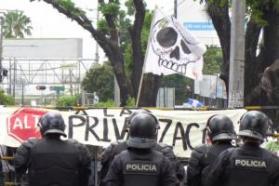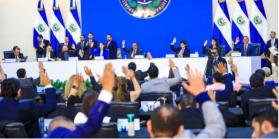Remembering Romero: Thirty years later
I stood at the back of a small sanctuary, looking up the aisle toward thewooden pulpit. I imagined sitting in the pews, listening to Monseñor Romerogiving Mass. What had it been like for the congregants on the morning of March24, 1980, witnessing his murder? I was struck by a sense of awe and humility:what must it have been like for him to stand up there at the pulpit? What kindof strength and courage must it have taken to continue to speak out, knowing hecould be killed at any time?
It was 2004 and I was on my first delegation to El Salvador. Across thestreet from the church, I stood in a small room in the house where he lived,which has since been turned into a museum. Reading quotes from his popularMasses, I started to get a sense of the depth of the faith that sustained andguided him, and how profoundly he believed his famous declaration: “Si me matan, me resucitaré en la lucha delpueblo salvadoreño” (“If they kill me, I will rise again in the struggle ofthe Salvadoran people”).
Monseñor Óscar Romero, Archbishop of San Salvador and “la voz de los sin voz” (“the voice of the voiceless”) is revered bySalvadorans for his ministry, his unflinching advocacy for El Salvador’s poormajority and open condemnation of U.S.-funded repression by the right wingSalvadoran government, which resulted in his assassination on March 24, 1980.
His sacrifice was indeed a catalyst for thousands more Salvadorans to puttheir own lives at risk and join the struggle for popular liberation. It wasalso a lighting rod for the international community, bringing cities, churchesand individuals into the Central American solidarity movement. The principlesof liberation theology inspired much of the popular organizing in ruralSalvadoran communities throughout the 1980s. If it weren’t for the physical andtactical support of the Christian base communities, the guerrilla forces would not have been able to outmaneuver theU.S.-backed military forces.
In the years since that first delegation to El Salvador, I have learned thatMonseñor Romero was in many ways not unique. CISPES organizer Yeni Solis oncetold me, “The success of the Salvadoran revolutionary process has been thatthere are no single heroes. There have been thousands, such that when one fell,another would be there to take his or her place.” Monseñor Romero’s commitmentto the self-liberation of poor and working people, the struggle for true peaceand democracy, and the willingness to make personal sacrifice for thecollective well-being is shared by the hundreds of thousands of people whocontinue to organize today as part of the FMLN and the Salvadoran socialmovement. These are the same principles that led to “the triumph of hope overfear” in the 2009 elections, when the FMLN won the most number of seats in the legislativeelections and the presidency.
At his inauguration last June, Mauricio Funes dedicated his presidency toMonseñor Romero, who had been a mentor of his during his brief time at theUniversity of Central America. It was a transformative moment in Salvadoranhistory, especially thrilling because the former ARENA presidents were allsitting right in the front rows. As presidents, they had publicly revered theirparty’s founder Roberto D’Abuisson, architect of Salvadoran death squads, whoinfamously said, “the person who killed Monseñor Romero is a hero”.
On Wednesday, March 24, 2010, the 30th anniversary of Archbishop Romero’sassassination, President Funes took another step toward justice for the 70,000civilians who were killed in the war. For the very first time, the Salvadorangovernment acknowledged and apologized for its role in Romero’s murder by aState-linked death squads. At a public ceremony to unveil a new mural dedicatedto Romero at the Comalapa Airport, President Funes stated, "I ask forgivenessin the name of the Salvadoran State for this assassination, perpetrated 30years ago, firstly from his family, secondly from the Salvadoran people andthirdly from the Catholic Church and religious organizations,” declaredFunes. Monseñor Romero’s brother, Gaspar Romero, formally accepted thelong-awaited government apology, responding, “With humility, love andgratitude, I accept this request for pardon, even though it comes 30 yearslater.”
This is an historic shift in El Salvador, hugely significant in the lives ofmany Salvadorans, both those who continue the struggle for justice and lastingpeace in El Salvador and those who were forced to flee the country during the1970s and 1980s because of horrific state repression. This shift is especiallyurgent today, when environmental activists like Marcelo Rivera, Ramiro Riveraand Dora Alicia Sorto Recinos – and young political leaders like Hector Venturaand Wilber Funes – are once again being targeted and killed by hit men andself-proclaimed “social cleansing groups.”
But the spirit of Monseñor Romero lives on. A family member of murderedanti-mining activist Ramiro Rivera recently told us, “Ramiro knew that he wouldbe killed. But he told me that sometimes, something really shocking has tohappen for others to wake up. He said that if his death would inspire theyounger generation to join the struggle to defend their community, then he waswilling to give his life.” At CISPES, we hope to live up to the memory of thosewho have given their lives to the struggle by supporting the next generation ofSalvadoran solidarity activists. For more information on our “Radical Roots”delegation – led by and for young Salvadoran-American activists – in June 2010,please visit www.cispes.org. ¡Romero vive! ¡La lucha sigue!



